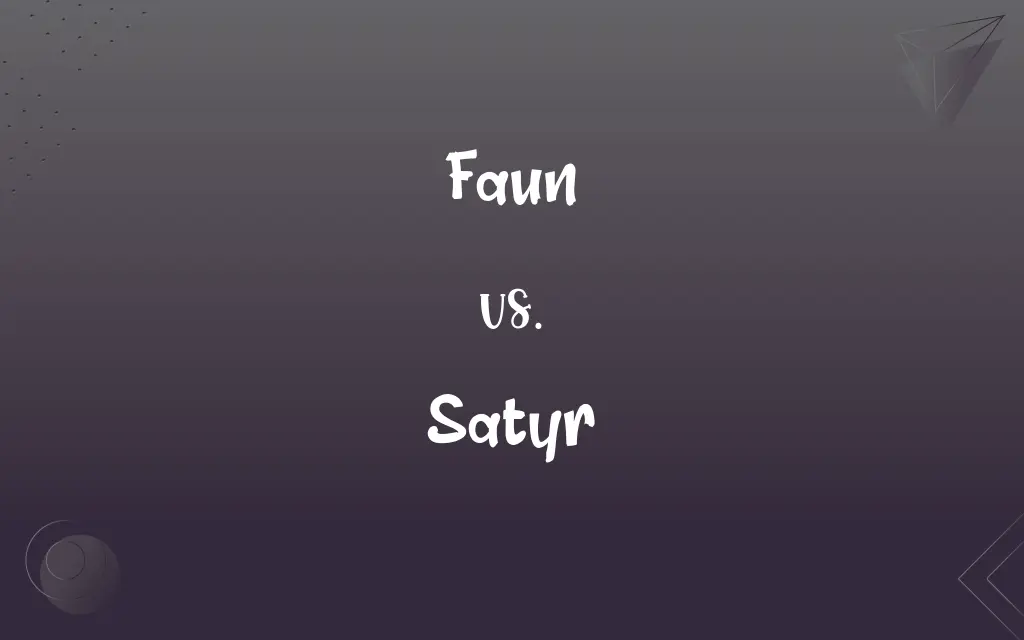Faun vs. Satyr: What's the Difference?
Edited by Aimie Carlson || By Janet White || Published on February 23, 2024
Fauns are peaceful, forest-dwelling creatures from Roman mythology with human bodies and goat's legs, whereas Satyrs, from Greek mythology, are more unruly, half-human, half-goat beings, often associated with Dionysus.

Key Differences
Fauns, originating in Roman mythology, are often depicted as gentle, whimsical beings, guardians of forests and natural environments. Satyrs, on the other hand, hail from Greek mythology and are known for their association with Dionysus, the god of wine, representing indulgence and excess.
In terms of physical appearance, Fauns are characterized by having the lower body of a goat and the upper body of a human, with a generally benevolent demeanor. Satyrs share similar physical traits but are often portrayed with more pronounced animalistic features, such as tails, pointed ears, and sometimes even snub noses, embodying a wilder nature.
Fauns are depicted as shy, elusive creatures, fond of playing flutes and haunting the quiet places of the wood. Satyrs, contrastingly, are depicted as mischievous, often indulging in revelry, music, dance, and pursuit of nymphs, embodying a spirit of unbridled freedom and hedonism.
In cultural depictions, Fauns are often associated with tranquility and are less prominent in mythological stories. Satyrs, however, are frequently portrayed in myths, art, and literature, symbolizing unrestrained passion and the untamed aspects of nature.
In modern interpretations, Fauns often symbolize harmony with nature and innocence. Satyrs, conversely, have become synonymous with unruly behavior and carnal desires, often used in literature and art to represent the wild, untamed side of humanity.
ADVERTISEMENT
Comparison Chart
Origin
Roman mythology
Greek mythology
Physical Appearance
Human upper body, goat's legs
More animalistic, often with tails and ears
Behavior
Gentle, nature-loving, musical
Mischievous, indulgent, revelrous
Mythological Role
Forest guardians, less involved in stories
Followers of Dionysus, active in myths
Cultural Representation
Symbolize peace and nature
Represent wildness and excess
ADVERTISEMENT
Faun and Satyr Definitions
Faun
A faun is a mythological half-human, half-goat creature from Roman lore.
The faun played a melody on his flute as he wandered through the forest.
Satyr
Physically, satyrs are depicted with animalistic features like tails, ears, and sometimes horns.
The satyr's pointed ears twitched as it listened to the sounds of the forest.
Faun
Fauns are depicted as guardians of forests and natural environments in Roman mythology.
In the moonlight, a faun could be seen guarding the ancient grove.
Satyr
A satyr is a creature from Greek mythology, half-man, half-goat, and often unruly.
The satyr danced wildly around the bonfire, celebrating the festival of Dionysus.
Faun
In Roman tales, fauns are known for their musical abilities, especially with flutes.
The faun's flute music echoed softly, creating a serene atmosphere in the woods.
Satyr
In myths, satyrs are often portrayed as indulgent, pursuing music, dance, and pleasure.
The satyr played his panpipes, leading a procession of dancers through the village.
Faun
A faun is often characterized by its human torso and goat's legs, embodying peacefulness.
A gentle faun approached the travelers, its goat legs making little sound on the forest floor.
Satyr
Satyrs are known for their association with Dionysus, the Greek god of wine and festivity.
In the myth, the satyr accompanied Dionysus on many adventures, reveling in the celebrations.
Faun
Fauns symbolize harmony with nature and are often portrayed as shy and elusive.
The faun, a symbol of nature's harmony, shyly peeked from behind a tree.
Satyr
Satyrs symbolize the untamed aspects of nature and human desires in Greek mythology.
The satyr, representing unbridled nature, chased after the nymph through the woods.
Faun
Any of numerous rural deities represented as having the body of a man and the horns, ears, tail, and sometimes legs of a goat.
Satyr
Often Satyr Greek Mythology A woodland creature depicted as having the pointed ears, legs, and short horns of a goat and a fondness for unrestrained revelry.
Faun
(Roman mythology) A woodland creature with pointed ears, legs, and short horns of a goat and a fondness for unrestrained revelry.
Faun
(entomology) Any of various nymphalid butterflies of the genus Faunis.
Faun
A god of fields and shipherds, diddering little from the satyr. The fauns are usually represented as half goat and half man.
Satyr or Faun, or Sylvan.
Faun
Ancient Italian deity in human shape, with horns, pointed ears and a goat's tail; equivalent to Greek satyr
FAQs
What is a Faun?
A faun is a mythological creature from Roman mythology, with the body of a human and the legs of a goat.
How do Fauns typically behave?
Fauns are typically portrayed as peaceful, shy, and in harmony with nature.
Are Fauns associated with any gods or goddesses?
Fauns are not specifically associated with any gods or goddesses in Roman mythology.
What are the typical behaviors of Satyrs?
Satyrs are often depicted as mischievous, indulgent, and fond of revelry.
Which god are Satyrs most closely associated with?
Satyrs are closely associated with Dionysus, the Greek god of wine and festivity.
What do Fauns symbolize in mythology?
Fauns symbolize peace, nature, and tranquility in Roman mythology.
What is a Satyr?
A satyr is a Greek mythological being, part human and part goat, known for its rowdy and indulgent behavior.
Do Fauns play a role in any famous myths?
Fauns appear in various Roman myths but are not central figures like in some Greek myths.
Where do Fauns originate from?
Fauns originate from Roman mythology.
What mythology are Satyrs associated with?
Satyrs are associated with Greek mythology.
Are Satyrs featured prominently in Greek myths?
Yes, Satyrs are featured prominently in several Greek myths, often in stories involving Dionysus.
What do Satyrs represent in Greek mythology?
Satyrs represent wildness, excess, and the untamed aspects of nature in Greek mythology.
Can Fauns be female?
Fauns are typically depicted as male, but female versions, though rare, exist in some stories.
What instruments are Fauns known for playing?
Fauns are often depicted playing flutes or panpipes.
What is a distinguishing feature of Satyrs?
Satyrs are distinguished by their half-human, half-goat appearance, often with pointed ears and tails.
Are Fauns considered benevolent?
Yes, Fauns are generally considered benevolent and gentle in mythology.
What is a common depiction of Satyrs in art?
Satyrs are commonly depicted in art as wild, dancing, or chasing nymphs.
Are there female Satyrs?
Traditionally, Satyrs are male, but similar female creatures are called nymphs or maenads in Greek mythology.
Are Satyrs considered good or evil in myths?
Satyrs are neither strictly good nor evil but are often portrayed as hedonistic and chaotic.
How are Fauns different from Centaurs?
Fauns have the lower body of a goat, while Centaurs have the lower body of a horse.
About Author
Written by
Janet WhiteJanet White has been an esteemed writer and blogger for Difference Wiki. Holding a Master's degree in Science and Medical Journalism from the prestigious Boston University, she has consistently demonstrated her expertise and passion for her field. When she's not immersed in her work, Janet relishes her time exercising, delving into a good book, and cherishing moments with friends and family.
Edited by
Aimie CarlsonAimie Carlson, holding a master's degree in English literature, is a fervent English language enthusiast. She lends her writing talents to Difference Wiki, a prominent website that specializes in comparisons, offering readers insightful analyses that both captivate and inform.






































































